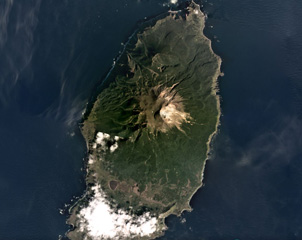Report on Rasshua (Russia) — March 1989
Scientific Event Alert Network Bulletin, vol. 14, no. 3 (March 1989)
Managing Editor: Lindsay McClelland.
Rasshua (Russia) Fumarolic areas in the crater
Please cite this report as:
Global Volcanism Program, 1989. Report on Rasshua (Russia) (McClelland, L., ed.). Scientific Event Alert Network Bulletin, 14:3. Smithsonian Institution. https://doi.org/10.5479/si.GVP.SEAN198903-290220
Rasshua
Russia
47.77°N, 153.02°E; summit elev. 956 m
All times are local (unless otherwise noted)
Four groups of fumaroles were observed in a crater, breached to the SE, during a 14 January overflight.
Geological Summary. The elongated 6 x 13 km island of Rasshua in the central Kuriles contains three overlapping central cones within a 6 km caldera whose eastern margin is beyond the shoreline. An eroded central cone was constructed during the late Pleistocene, along with an isolated cone near the NW coast. Two Holocene cones were built within the crater of the central cone. The westernmost forms the 956 m high point of the island and is the source of lava flows that flooded the crater floor and descended to the coast. The easternmost cone, active during historical time, is truncated by a 500-m-wide crater that is breached to the SE. This crater may have formed during a violent eruption in 1846. The only other known historical eruption produced weak explosions in 1957. Fumarolic activity continues in the eastern crater and in the saddle between the two summit cones.
Information Contacts: G. Steinberg, Yuzhno-Sakhalinsk.

